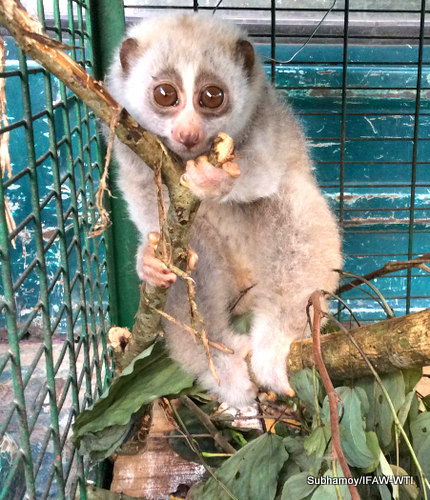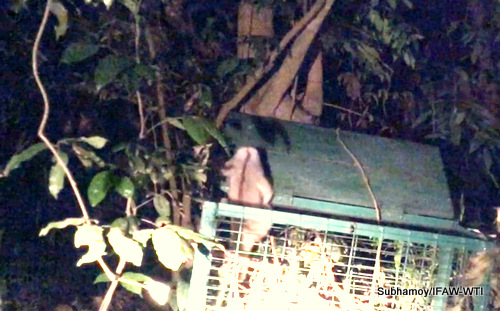Sub-adult Slow Loris Released Back to the Wild
Jamuguri, May 3, 2015: After spending more than a week at the Centre for Wildlife Rehabilitation and Conservation (CWRC) — the IFAW-WTI wildlife care facility in Assam– a female sub-adult slow loris was released back into the wild. This nocturnal animal was spotted by villagers of Jamuguri in Golaghat district of Assam, who reported its presence to the Forest Department on April 25, 2015. Alerted by the situation, the forest staff rescued the animal from the human habitat and handed it over to the CWRC team for further observation.
Once the animal was shifted to CWRC, the IFAW-WTI veterinarians, led by Dr. Panjit Basumatary, examined it and suggested that the slow loris be kept for a week for body morphometry and faecal sample study. After a week, the animal exhibited no behavioural changes and it was decided that it should be released back into the wild.
Interestingly, the slow loris’ presence in the area around created a hue and cry since the animal was not known to the locals. The animal was then caught by the villagers who kept it with them till the forest department came to its rescue. A nocturnal animal, slow loris cannot move during the day and it is believed that the animal must have come into human habitation to feed at night.
Finally on May 3, the sub-adult loris was released in Deopahar Hills, under Golaghat Forest Divsion, which is in close vicinity to the place from where it was found. After the release, the animal slowly climbed up the trees and disappeared into the forest, bringing joy to the CWRC IFAW-WTI MVS team and the forest beat officials who monitored the entire process.
The Centre for Wildlife Rehabilitation and Conservation (CWRC) is the first rescue and rehabilitation centre near a protected area in India. Strategically located in Borjuri village adjacent to the Panbari Reserve Forest, near Kaziranga National Park in Assam, the centre attends to a wide range of wildlife emergencies resulting from natural or anthropogenic causes. CWRC has handled over 3500 cases of distressed wild animals (of over 230 species) essentially handling nearly one case per day since 2002.











